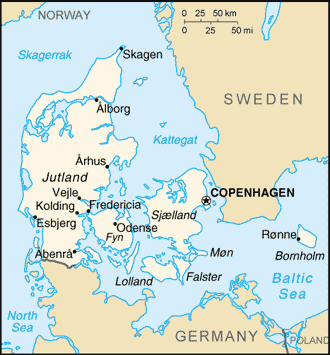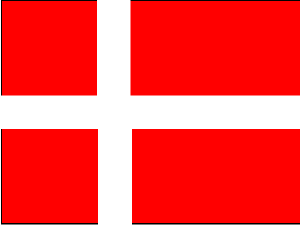
|
Denmark
Background:
Once the seat of Viking raiders and later a major north European power, Denmark
has evolved into a modern, prosperous nation that is participating in the
general political and economic integration of Europe. However, the country has
opted out of European Union's Maastricht Treaty, the European monetary system
(EMU), and issues concerning certain internal affairs.
Location:
Northern Europe, bordering the Baltic Sea and the North Sea, on a
peninsula north of Germany (Jutland); also includes two major islands
(Sjaelland and Fyn).
Area: Total: 43,094 sq km, water: 700 sq km, note: includes the island of
Bornholm in the Baltic Sea and the rest of metropolitan Denmark (the Jutland
Peninsula, and the major islands of Sjaelland and Fyn), but excludes the Faroe
Islands and Greenland land: 42,394 sq km.
Area - comparative: Slightly less than twice the size of Massachusetts.
Land boundaries: Total: 68 km border countries: Germany 68 km.
Coastline: 7,314 km.
Climate and Terrain:
Climate: Temperate; humid and overcast; mild, windy winters and cool summers.
Terrain: Low and flat to gently rolling plains.
Natural resources: Petroleum, natural gas, fish, salt, limestone, stone, gravel
and sand
People:
Population: 5,368,854.
Ethnic groups: Scandinavian, Inuit, Faroese, German, Turkish, Iranian, Somali.
Religions: Evangelical Lutheran 95%, other Protestant and Roman Catholic 3%,
Muslim 2%.
Languages: Danish, Faroese, Greenlandic (an Inuit dialect), German (small
minority), note: English is the predominant second language.
Government:
Government type: Constitutional monarchy.
Capital: Copenhagen.
Independence: First organized as a unified state in 10th century; in 1849
became a constitutional monarchy.
Economy overview:
This thoroughly modern market economy features high-tech agriculture,
up-to-date small-scale and corporate industry, extensive government welfare
measures, comfortable living standards, a stable currency, and high dependence
on foreign trade. Denmark is a net exporter of food and energy and has a
comfortable balance of payments surplus. The government has been successful in
meeting, and even exceeding, the economic convergence criteria for
participating in the third phase (a common European currency) of the European
Monetary Union (EMU), but Denmark, in a September 2000 referendum, reconfirmed
its decision not to join the 11 other EU members in the euro. Even so, the
Danish currency remains pegged to the euro.
GDP - composition by sector: Agriculture: 3%, industry: 22%, services: 75%.
Statistics:
Telephones - main lines in use: 4.785 million.
Telephones - mobile cellular: 1,444,016.
Radio broadcast stations: AM 2, FM 355.
Radios: 6.02 million.
Television broadcast stations: 26.
Televisions: 3.121 million.
Internet users: 2.93 million.
Railways: Total: 2,859 km.
Highways: Total: 71,474 km.
Airports: 116,
with paved runways: 28,
with unpaved runways: 88.
Return to Visiting Locations
|

